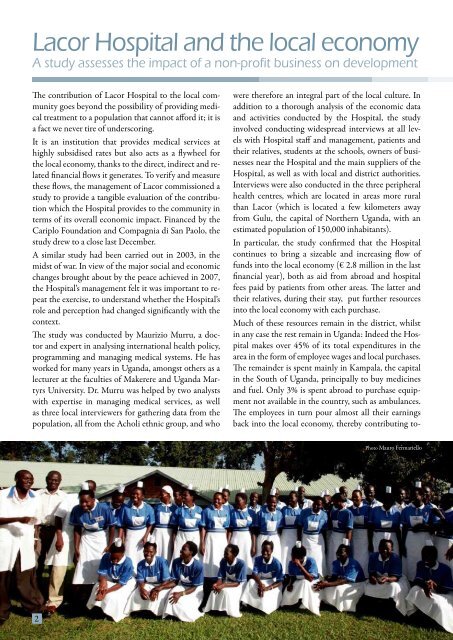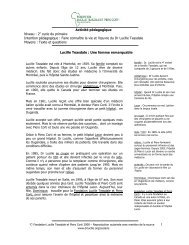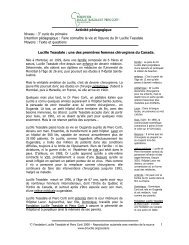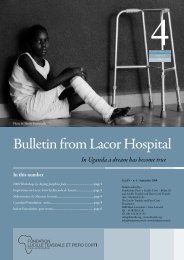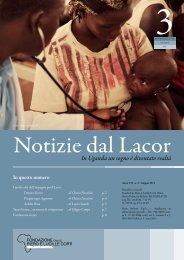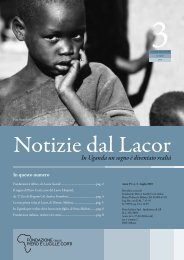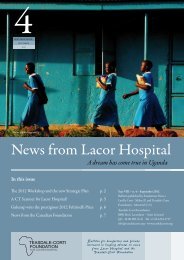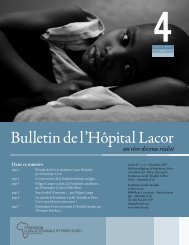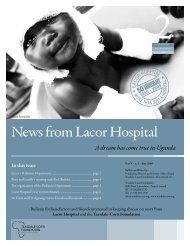A dream has come true in Uganda - Fondazione Corti
A dream has come true in Uganda - Fondazione Corti
A dream has come true in Uganda - Fondazione Corti
Create successful ePaper yourself
Turn your PDF publications into a flip-book with our unique Google optimized e-Paper software.
Lacor Hospital and the local economy<br />
A study assesses the impact of a non-profit bus<strong>in</strong>ess on development<br />
The contribution of Lacor Hospital to the local community<br />
goes beyond the possibility of provid<strong>in</strong>g medical<br />
treatment to a population that cannot afford it; it is<br />
a fact we never tire of underscor<strong>in</strong>g.<br />
It is an <strong>in</strong>stitution that provides medical services at<br />
highly subsidised rates but also acts as a flywheel for<br />
the local economy, thanks to the direct, <strong>in</strong>direct and related<br />
f<strong>in</strong>ancial flows it generates. To verify and measure<br />
these flows, the management of Lacor commissioned a<br />
study to provide a tangible evaluation of the contribution<br />
which the Hospital provides to the community <strong>in</strong><br />
terms of its overall economic impact. F<strong>in</strong>anced by the<br />
Cariplo Foundation and Compagnia di San Paolo, the<br />
study drew to a close last December.<br />
A similar study had been carried out <strong>in</strong> 2003, <strong>in</strong> the<br />
midst of war. In view of the major social and economic<br />
changes brought about by the peace achieved <strong>in</strong> 2007,<br />
the Hospital’s management felt it was important to repeat<br />
the exercise, to understand whether the Hospital’s<br />
role and perception had changed significantly with the<br />
context.<br />
The study was conducted by Maurizio Murru, a doctor<br />
and expert <strong>in</strong> analys<strong>in</strong>g <strong>in</strong>ternational health policy,<br />
programm<strong>in</strong>g and manag<strong>in</strong>g medical systems. He <strong>has</strong><br />
worked for many years <strong>in</strong> <strong>Uganda</strong>, amongst others as a<br />
lecturer at the faculties of Makerere and <strong>Uganda</strong> Martyrs<br />
University. Dr. Murru was helped by two analysts<br />
with expertise <strong>in</strong> manag<strong>in</strong>g medical services, as well<br />
as three local <strong>in</strong>terviewers for gather<strong>in</strong>g data from the<br />
population, all from the Acholi ethnic group, and who<br />
42<br />
were therefore an <strong>in</strong>tegral part of the local culture. In<br />
addition to a thorough analysis of the economic data<br />
and activities conducted by the Hospital, the study<br />
<strong>in</strong>volved conduct<strong>in</strong>g widespread <strong>in</strong>terviews at all levels<br />
with Hospital staff and management, patients and<br />
their relatives, students at the schools, owners of bus<strong>in</strong>esses<br />
near the Hospital and the ma<strong>in</strong> suppliers of the<br />
Hospital, as well as with local and district authorities.<br />
Interviews were also conducted <strong>in</strong> the three peripheral<br />
health centres, which are located <strong>in</strong> areas more rural<br />
than Lacor (which is located a few kilometers away<br />
from Gulu, the capital of Northern <strong>Uganda</strong>, with an<br />
estimated population of 150,000 <strong>in</strong>habitants).<br />
In particular, the study confirmed that the Hospital<br />
cont<strong>in</strong>ues to br<strong>in</strong>g a sizeable and <strong>in</strong>creas<strong>in</strong>g flow of<br />
funds <strong>in</strong>to the local economy (€ 2.8 million <strong>in</strong> the last<br />
f<strong>in</strong>ancial year), both as aid from abroad and hospital<br />
fees paid by patients from other areas. The latter and<br />
their relatives, dur<strong>in</strong>g their stay, put further resources<br />
<strong>in</strong>to the local economy with each purc<strong>has</strong>e.<br />
Much of these resources rema<strong>in</strong> <strong>in</strong> the district, whilst<br />
<strong>in</strong> any case the rest rema<strong>in</strong> <strong>in</strong> <strong>Uganda</strong>: Indeed the Hospital<br />
makes over 45% of its total expenditures <strong>in</strong> the<br />
area <strong>in</strong> the form of employee wages and local purc<strong>has</strong>es.<br />
The rema<strong>in</strong>der is spent ma<strong>in</strong>ly <strong>in</strong> Kampala, the capital<br />
<strong>in</strong> the South of <strong>Uganda</strong>, pr<strong>in</strong>cipally to buy medic<strong>in</strong>es<br />
and fuel. Only 3% is spent abroad to purc<strong>has</strong>e equipment<br />
not available <strong>in</strong> the country, such as ambulances.<br />
The employees <strong>in</strong> turn pour almost all their earn<strong>in</strong>gs<br />
back <strong>in</strong>to the local economy, thereby contribut<strong>in</strong>g to-<br />
Photo Mauro Fermariello


